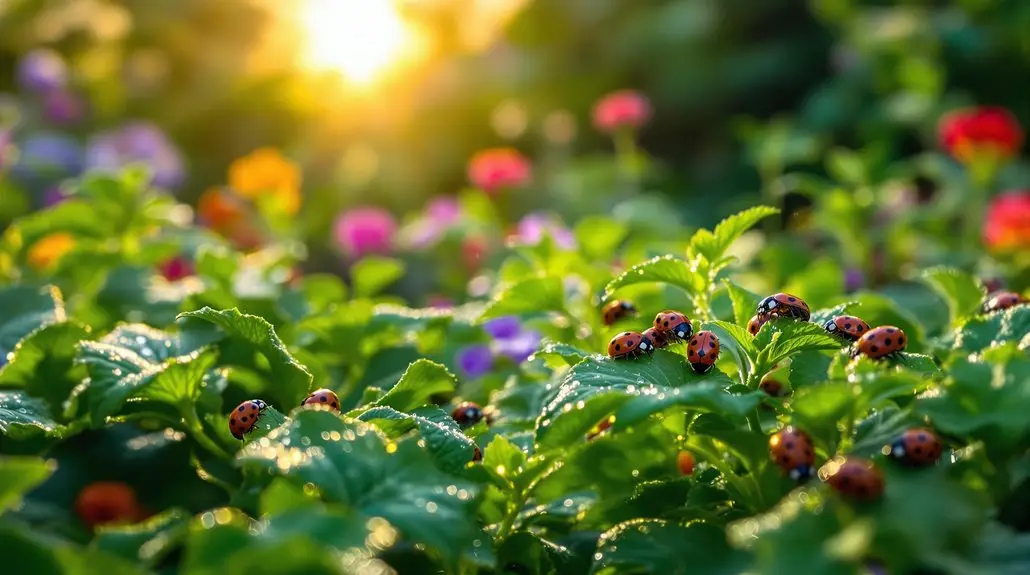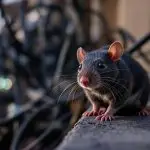Ladybug pest control for gardens definitely works. These little insects can eat up to 5,000 aphids in their lifetime, making them powerful allies against common garden pests. They also help maintain a balanced ecosystem, reducing the need for chemical pesticides. However, successful control depends on proper release and management. For instance, timing and hydration are essential to keep ladybugs from leaving your garden too soon. You’ll want to take into account native species for the best results. If you’re curious about how to make ladybugs work for you, there’s plenty more to explore on this effective gardening method.
Key Insights
- Ladybugs can consume hundreds of aphids daily, making them effective natural pest controllers in gardens.
- Their presence enhances biodiversity and indicates a healthy garden ecosystem, supporting organic gardening principles.
- For optimal results, release a substantial quantity of ladybugs and at the right time to minimize flight away.
- Native ladybugs are better suited for local environments and contribute positively to pest control without disrupting ecological balance.
- Incorporating ladybugs into Integrated Pest Management (IPM) can enhance their effectiveness in managing diverse pest populations.
Effectiveness of Ladybugs
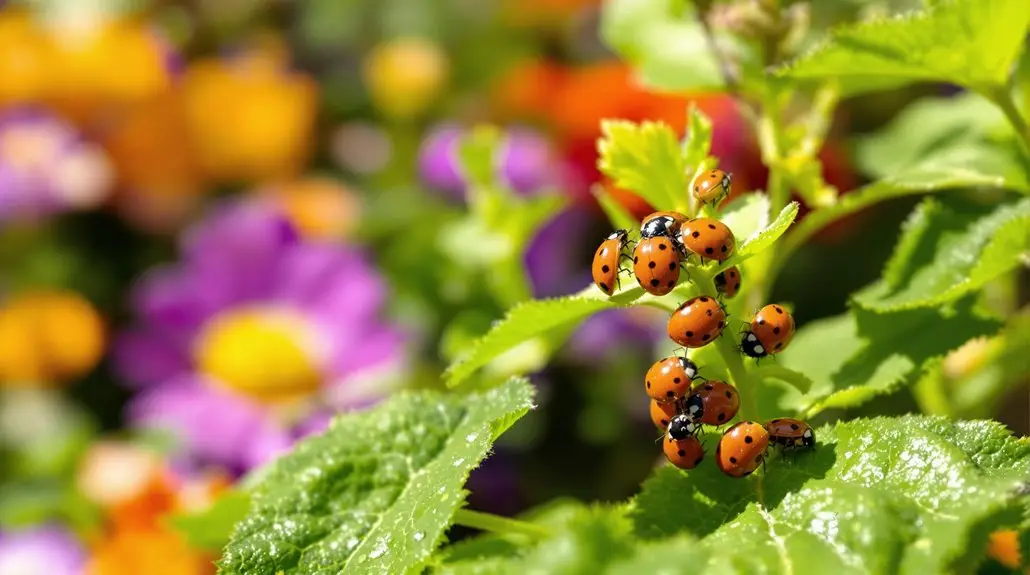
Ladybugs are powerful allies in the battle against garden pests. When you introduce these charming insects into your garden, you’re inviting effective predators that can tackle a range of troublesome pests.
Ladybugs are particularly effective against aphids, devouring hundreds in just one day. They also feast on other soft-bodied insects like mites, whiteflies, and mealybugs, which can wreak havoc on your plants.
What’s more, ladybugs are generalist predators, meaning they don’t just target one type of pest. They help control pests like broccoli worms, tomato hornworms, and cabbage moths, providing you with a diverse defense system.
Their ability to hone in on specific pests, thanks to pheromones released by these insects, makes them even more efficient.
When you release ladybugs, you’ll notice their rapid population control capabilities. They lay clusters of eggs near pest populations, and their hungry larvae emerge ready to feast. This quick reproduction allows ladybugs to maintain a balanced ecosystem in your garden, as long as there’s a healthy population of aphids available.
To maximize their effectiveness, try releasing them in the evening or watering your plants beforehand. This way, they’re more likely to stick around.
Environmental Benefits
When you choose ladybugs for pest control, you’re opting for an eco-friendly method that supports biodiversity and ecosystem health. By attracting these beneficial insects, you help create a balanced environment in your garden. This approach not only reduces the need for chemical pesticides but also fosters a thriving habitat for various species. Additionally, maintaining a healthy environment supports ladybug populations as a preventative measure. Implementing natural pest control methods, like ladybug introduction, aligns with the principles of organic pest control that minimize chemical use and prioritize sustainability.
Eco-Friendly Pest Management
Incorporating ladybug pest control into your garden not only enhances plant health but also promotes a balanced ecosystem. By inviting these beneficial insects, you create a welcoming environment that nurtures life rather than disrupts it. Ladybugs specifically target harmful pests, ensuring that beneficial insects and pollinators thrive alongside them. Unlike chemical pesticides that can harm a wide range of insects, ladybugs respect the delicate balance of nature.
Choosing ladybugs means reducing your reliance on toxic pest control products. This eco-friendly approach eliminates harmful residues on your plants and helps maintain a healthier garden. Additionally, ladybugs can consume large quantities of pests, including hundreds of aphids daily, making them an effective natural solution. Furthermore, using natural pest control methods like ladybugs aligns with sustainable gardening practices.
Plus, ladybugs don’t contaminate the soil or water, making your gardening practices more secure for the environment and your community. With ladybugs patrolling your garden year-round, you can establish a sustainable pest management solution. They reproduce quickly, and their larvae are voracious predators, ensuring continuous pest control without the need for harsh chemicals.
By embracing ladybug pest control, you join a community of gardeners who prioritize clean, healthy ecosystems and contribute to a more sustainable future. Your garden can thrive while protecting the planet—it’s a win-win for you and nature!
Biodiversity and Ecosystem Health
A thriving garden benefits immensely from biodiversity, and ladybugs play a significant role in maintaining ecosystem health. These little wonders help control pest populations, particularly aphids, which can wreak havoc on your plants. By keeping these pests in check, ladybugs not only protect your garden but also reduce the need for harmful chemical pesticides that can contaminate soil and water. Their presence is a strong indicator of a healthy environment, signaling that your garden is a vibrant ecosystem. Moreover, ladybugs serve as an essential food source for birds and small mammals, contributing to a balanced food web. Studies show that ladybugs can consume up to 50 aphids daily, showcasing their effectiveness in pest control. Additionally, the practice of Integrated Pest Management (IPM) can further enhance the benefits of ladybug populations in gardens. However, their populations are sensitive to environmental changes, such as habitat loss and climate change. When ladybug numbers decline, it can disrupt the entire ecosystem, affecting the organisms that rely on them for survival.
Challenges of Using Ladybugs
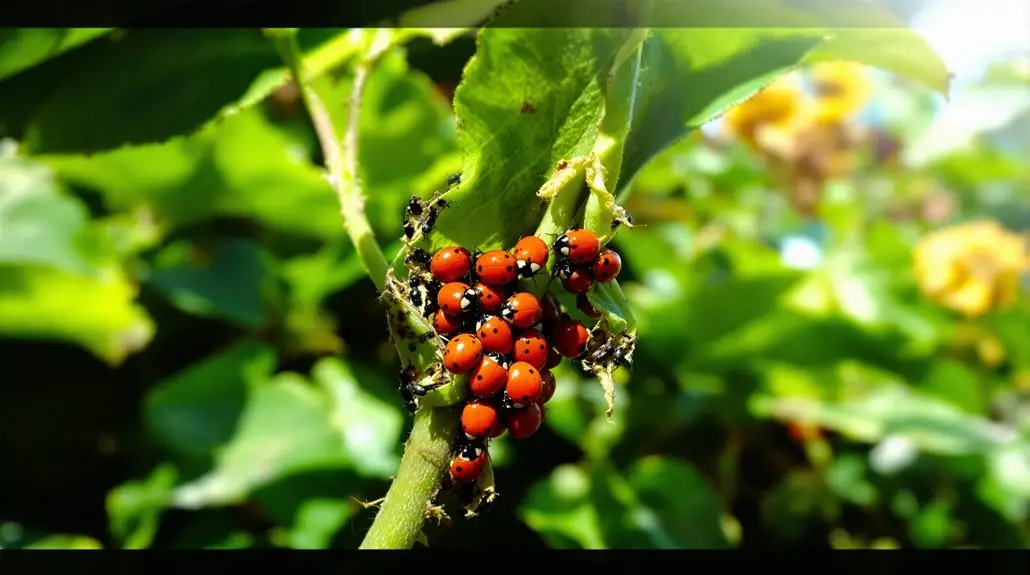
How can gardeners effectively manage the challenges of using ladybugs for pest control? While ladybugs can be a beneficial ally, you’ll face a few hurdles that could impact their effectiveness in your garden. Here’s what you need to take into account:
- Release Timing: It’s essential to release ladybugs during the evening or at dusk to minimize their urge to fly away.
- Quantity Matters: You’ll need a substantial number—around 1,500 ladybugs for every 100 square feet—to effectively tackle aphid populations.
- Survival Rate: Over 95% of ladybugs are likely to leave your garden within 48 hours unless you take steps to retain them. Natural predators like ladybugs are highly effective in controlling pest populations when properly managed. Additionally, consider that landscape insect pest control services can help maintain a balanced ecosystem in your garden.
To maximize your success, water your plants before releasing the ladybugs, providing them with the hydration they need. Avoid releasing them during the heat of the day, as this can also encourage them to take off.
It’s best to release them at the base of plants or in the crotches of low branches for better retention. Additionally, think about using netting to keep them around infested areas, and remember that ladybugs won’t lay eggs on the plants you release them on.
Native vs. Non-Native Ladybugs
When choosing ladybugs for your garden, it’s essential to take into account the benefits of native species versus the risks of non-native ones.
Native ladybugs are well-suited to your local environment, effectively controlling pests while integrating into the garden ecosystem. In contrast, non-native species can disrupt the balance and may not provide the same level of pest control, leading to potential long-term issues. Native ladybugs contribute to overall garden health by controlling pest populations, which is crucial for maintaining a healthy garden ecosystem.
Benefits of Native Ladybugs
Native ladybugs offer numerous advantages over their non-native counterparts, making them an essential ally in your garden. By choosing native species, you’re not just promoting a healthy ecosystem; you’re also ensuring effective pest control in a way that’s secure for your plants and the environment.
- They’re expert hunters, consuming hundreds of aphids daily, similar to how native species are utilized in pest management strategies.
- Their targeted approach minimizes harm to beneficial insects and pollinators.
- Using native ladybugs reduces reliance on harmful chemical pesticides. Research supports their effectiveness in controlled environments for pest control.
With their uncanny ability to detect specific pests using pheromones, native ladybugs focus on the troublemakers in your garden while leaving beneficial insects unharmed.
They’re also environmentally friendly, as they don’t contaminate your soil or water, promoting a balanced ecosystem.
Plus, their rapid reproduction means they can quickly establish a presence, controlling pests effectively.
Risks of Non-Native Species
Many gardeners mightn’t realize the risks associated with introducing non-native ladybug species into their gardens. While it may seem like a good idea, these non-native ladybugs can threaten the native varieties you cherish. They often compete for food and resources, leading to a decline in native ladybug populations.
Some, like the harlequin ladybug, even eat the larvae of your local species, disrupting the natural balance of your garden’s ecosystem. In addition to competition, non-native ladybugs can carry diseases and parasites that harm other beneficial insects. This can weaken the native ladybug populations you depend on for effective pest control.
Even worse, these non-native types may not be as efficient at managing pests, arriving late to infestations and allowing pests like aphids to multiply. Attracting native ladybugs can enhance natural pest control and help maintain a healthy garden ecosystem.
You want to create a thriving garden, and the last thing you need is an invasive species disrupting that harmony. By focusing on native ladybugs, you support biodiversity and guarantee that your garden thrives naturally.
Embrace your local ladybug community and watch your garden flourish!
Alternative Pest Control Methods
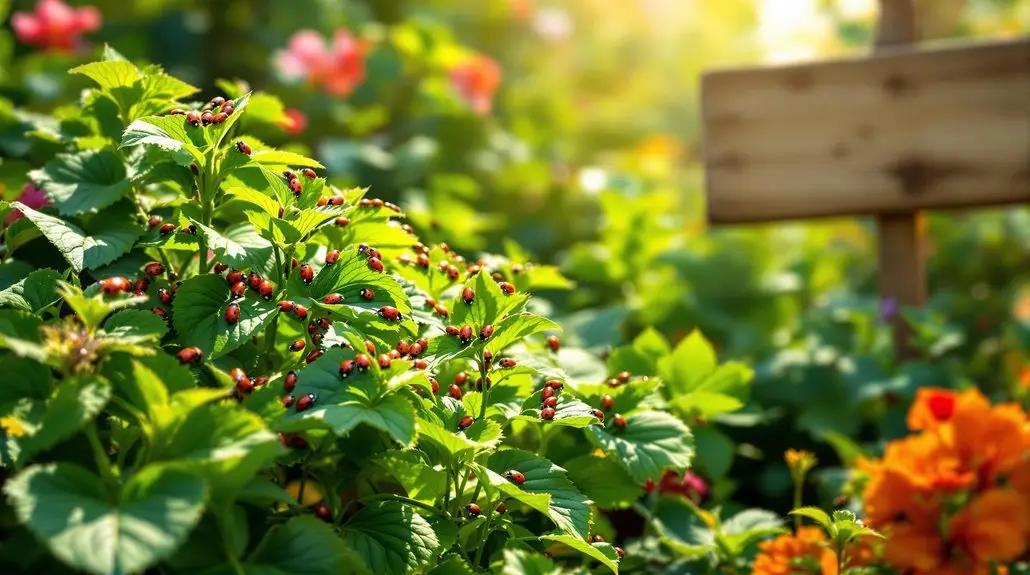
Exploring alternative pest control methods can offer effective solutions for managing garden pests without relying solely on chemical treatments. These methods not only protect your plants but also create a healthier environment for beneficial insects and wildlife.
Here are some fantastic alternatives to evaluate:
- Use insecticidal soap or oil sprays to target pests without harming good bugs.
- Implement companion planting, like yellow marigolds, to distract aphids from your prized plants.
- Try manual removal by hosing off or squishing pests directly.
One simple method is hosing off aphids with water. This low-toxicity approach can help keep your plants pest-free without introducing harmful chemicals. Interestingly, ladybugs can consume up to 5,000 aphids in their lifetime, making them a powerful ally in your garden’s pest control efforts.
Insecticidal soaps and oils are another great option, effectively controlling pests while preserving the beneficial insects that help your garden thrive.
Companion planting creates a natural balance in your garden. By choosing plants that attract beneficial insects or repel pests, you can create a diverse ecosystem that supports healthy growth.
For instance, yellow marigolds can lure aphids away from your veggies, giving ladybugs a chance to do their job.
Don’t overlook manual methods, either. Taking the time to blast aphids off your plants or squishing them can make a significant difference, especially in smaller gardens.
Attracting Ladybugs Naturally
To attract ladybugs naturally, start by planting ideal flowers like alyssum and marigolds that provide essential pollen and nectar. Creating an insect-friendly habitat by adding water sources and shelter ensures ladybugs feel welcome in your garden. Additionally, planting a variety of flowering plants can attract beneficial insects that further enhance your garden’s ecosystem.
Ideal Plants for Attraction
Attracting ladybugs to your garden can transform it into a vibrant ecosystem, enhancing both beauty and health.
These beneficial insects thrive on certain plants that not only provide nourishment but also create a welcoming environment. By carefully selecting the right plants, you can invite ladybugs into your garden and enjoy their natural pest control benefits.
- Alyssum: This nectar-rich flower draws ladybugs in with its sweet-smelling allure.
- Fennel: Known for its charming blooms, fennel acts as a magnet for these helpful insects.
- Marigolds: With their bright colors, marigolds not only beautify your garden but also attract ladybugs effortlessly.
To maximize your success, consider planting a diverse array of these flowers.
Group them together to create clusters, ensuring ladybugs can easily find their food sources.
Aim for a continuous blooming schedule, so there’s always something for ladybugs to feast on.
By embracing organic gardening practices and avoiding pesticides, you’ll create a secure haven for these delightful creatures.
With the right plants, you’ll truly cultivate a garden that thrives with ladybugs!
Creating Insect-Friendly Habitats
Creating a vibrant garden goes beyond just selecting the right plants; it also involves crafting an environment that nurtures ladybugs and other beneficial insects. Start by encouraging native ladybug populations to settle in your garden. This reduces the need for purchased ladybugs, which can introduce harmful non-native species.
By fostering a balanced ecosystem, you support local biodiversity and allow ladybugs to thrive naturally. To attract these helpful allies, plant pollinating flowers that provide alternative food sources like pollen. You can also create habitats by leaving some areas of your garden wild—think of native grasses or wildflowers.
When you release ladybugs, do it in the evening and make sure there’s a sufficient aphid population to keep them engaged. A fine mist of water on your plants will encourage them to stay, while placing them at the base of plants helps them find their food.
Integrated Pest Management
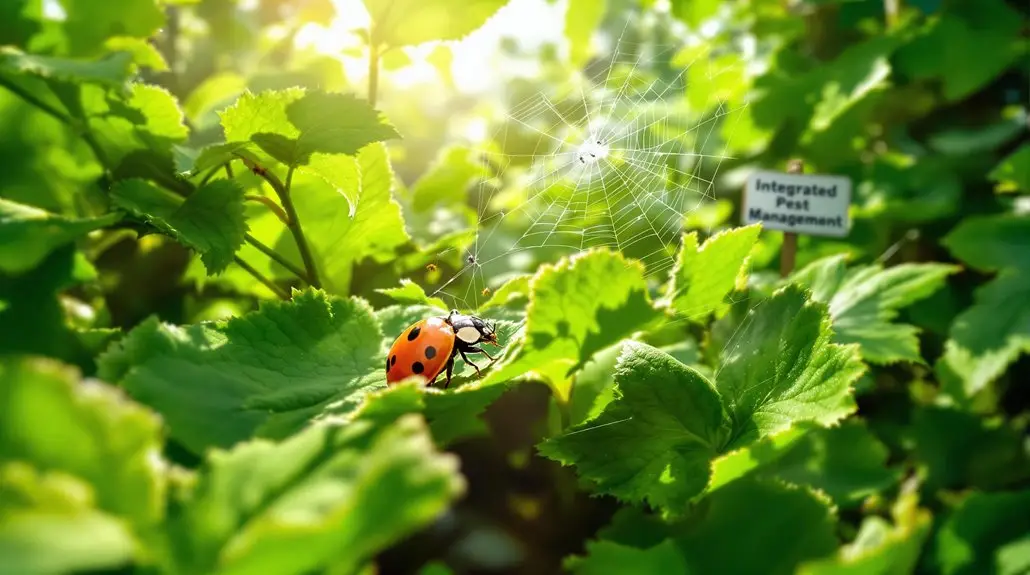
While pest control in gardens often leans on chemical solutions, integrated pest management (IPM) offers a more sustainable approach that balances ecological health with effective pest control. By combining multiple strategies, you can create a healthier garden environment that supports beneficial insects like ladybugs while effectively managing pests.
- IPM encourages using ladybugs and other natural predators to keep pest populations in check.
- It promotes practices like planting native flowers to attract beneficial insects and reduce reliance on chemicals.
- By monitoring pest levels and applying interventions only when necessary, you minimize harm to the ecosystem.
Incorporating IPM into your gardening routine can lead to a more resilient garden. Start by evaluating the pest situation before acting. If you spot an aphid infestation, consider introducing ladybugs to combat them.
Remember, releasing ladybugs is most effective when done in the evening, and you should verify there’s a good supply of aphids to keep them around longer.
However, be mindful of the release rate; for heavily infested plants, you may need up to 1,500 ladybugs, applied over time.
Also, consider environmental factors and avoid using insecticides that could harm these beneficial allies.
Declining Ladybug Populations
Ladybug populations have been declining in gardens for several reasons, impacting their effectiveness as natural pest controllers. When you release ladybugs into your garden, you’ll notice many tend to fly away, regardless of the presence of aphids. If you release them at night, it may reduce immediate dispersion, but it won’t stop it entirely.
To increase their chances of staying, make certain that their basic needs for food and water are met. Without sufficient prey, ladybugs might leave in search of a better food source.
Environmental factors also play a significant role. Ladybugs hibernate during winter and are most useful in spring and summer. If your garden experiences extreme temperatures, it can affect their activity and survival. Ideal temperatures range from 67-90°F, and prolonged adverse weather can harm their populations.
Additionally, your release strategy matters. If you buy non-native ladybug species, they mightn’t adapt well and could fly off quickly. Instead, consider releasing juvenile ladybugs or eggs since they’re less likely to disperse immediately.
Conservation Efforts
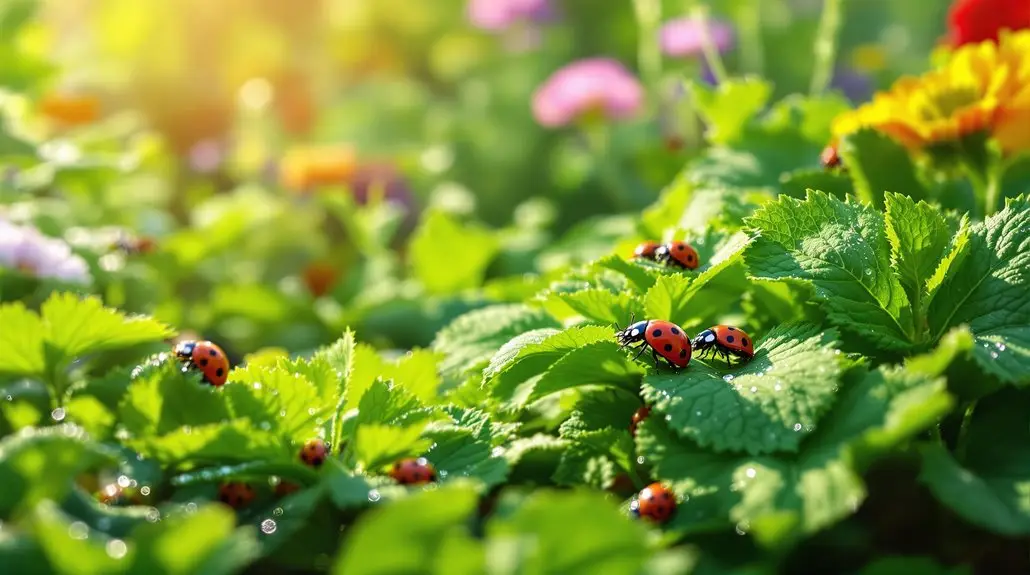
To protect and restore ladybug populations, a variety of conservation efforts are fundamental. Engaging with your community not only fosters a sense of belonging but also creates a collective impact. Here are some ways you can contribute:
- Participate in Citizen Science: Help monitor ladybug populations by reporting sightings and habitats.
- Educate Yourself and Others: Share knowledge about ladybug conservation through workshops or community events.
- Create Insect-Friendly Habitats: Plant flowers that attract ladybugs in your garden or local green spaces.
By involving citizen scientists, you can play a pivotal role in gathering essential data on ladybug behavior and ecological impact.
Collaborating with schools and community groups helps spread awareness about these beneficial insects. You can also utilize mobile apps and online platforms to submit your observations, making it easier for everyone to contribute.
Education programs are significant. By developing materials or integrating ladybug conservation into school curricula, you help raise awareness about their importance.
Partnering with environmental organizations can amplify your message, reaching a wider audience.
Lastly, enhancing habitats is key. Planting pollinating flowers and maintaining diverse landscapes not only supports ladybug populations but also benefits your local ecosystem.
Avoiding harmful insecticides guarantees that these little helpers can thrive.
Together, through these conservation efforts, you can make a difference, fostering a healthier environment for ladybugs and the gardens you cherish.
Practical Tips for Release
Releasing ladybugs effectively requires careful planning and attention to detail. First, choose an enclosed area like a greenhouse or nursery to minimize their dispersal. Avoid open spaces where they can quickly fly away. Make sure the release site is free of local predators that might threaten your ladybugs. The ideal temperature for their activity is between 67-90°F, so keep that in mind when selecting your environment.
Timing is vital. Release your ladybugs in the evening to increase the chances they’ll stick around. Daytime releases often lead to dispersal. If possible, consider releasing juvenile ladybugs or eggs, as they’re less likely to fly away immediately. It’s also smart to release them when aphid populations are high, giving your ladybugs an immediate food source. You might want to release them in stages to maintain a consistent presence in your garden.
Before releasing, stop using any insecticides, even natural ones, as they can be harmful. If you aren’t releasing all the ladybugs at once, keep the extras refrigerated to keep them dormant.
Use pollinating flowers to attract and feed them when pest populations decrease. Finally, make sure the ladybugs are native to your area to avoid environmental issues.
Best Practices for Gardens

Creating a thriving garden ecosystem involves implementing best practices that enhance pest control naturally. By embracing these strategies, you can foster a welcoming environment where ladybugs can thrive and keep those bothersome pests at bay.
- Plant pollinator-friendly flowers: Include alyssum, fennel, and marigolds to attract ladybugs to your garden.
- Hydrate your plants: Watering your plants before releasing ladybugs guarantees they’ve the hydration needed to settle in.
- Release at the right time: Releasing ladybugs in the evening increases their chances of sticking around.
When you create an inviting atmosphere for ladybugs, you’re not just controlling pests; you’re nurturing a balanced ecosystem. Ladybugs thrive on specific pests like aphids and whiteflies, so planting those pollinator-friendly flowers will draw them in naturally.
Remember that a single ladybug can devour hundreds of aphids in a day, making them powerful allies in your garden.
It’s vital to avoid using insecticides before and after releasing ladybugs, as these chemicals can harm them and disrupt your efforts. Additionally, consider using netting around infested plants to keep ladybugs focused on the pests you want to eliminate.
With these best practices, you’ll enjoy a vibrant garden full of life, where ladybugs play their important role in maintaining a healthy environment.
Together, you and your ladybug friends can create a flourishing garden ecosystem that everyone can admire.
Evaluating Pest Control Options
When considering pest control options for your garden, it’s vital to evaluate both the effectiveness and environmental impact of various methods. Ladybugs stand out as a natural solution, primarily targeting pests like aphids, mites, and whiteflies. Their ability to consume hundreds to thousands of these pests quickly makes them a formidable ally in maintaining your garden’s health.
Plus, they contribute to a balanced ecosystem by controlling pest populations without harming beneficial insects or pollinators.
However, it’s important to acknowledge the potential challenges. Many ladybugs tend to disperse shortly after release, especially if they’re let loose during the day. To maximize their effectiveness, release them at dusk or in enclosed areas where they can thrive. High release rates can also help guarantee that enough ladybugs stay in your garden to make a noticeable difference.
Combining ladybugs with other pest control methods can enhance your efforts. For instance, hosing off aphids can be an effective supplementary strategy, while insecticidal soaps can assist when ladybugs aren’t enough.
Encouraging a diverse ecosystem in your garden not only supports ladybugs but also invites other natural predators to help keep pests at bay.
Ultimately, evaluating pest control options means considering both the immediate results and the long-term health of your garden. By choosing methods that promote ecological balance, you can cultivate a thriving, pest-free environment that you can be proud of.
Frequently Asked Questions
How Do Ladybugs Find Their Way Back to the Garden?
Ladybugs use their keen sense of smell to find their way back to your garden. They detect pheromones released by aphids and other pests, guiding them to food sources.
When you create a welcoming environment with plenty of water and pest availability, they’re more likely to stick around. If they don’t find enough to eat, they might fly off, so make certain your garden stays healthy and inviting for these beneficial insects!
Can Ladybugs Harm Beneficial Plants or Crops?
You’re worried about whether ladybugs might harm your plants, right? The good news is, they won’t!
Ladybugs primarily target pests like aphids, leaving your beneficial plants and crops unharmed. They’re allies in the garden, promoting a healthy ecosystem while ensuring your plants thrive.
Unlike chemical pesticides, ladybugs won’t contaminate your soil or water. So, embrace these little helpers; they’ll work tirelessly to protect your garden without causing any damage.
Do Ladybugs Have a Specific Season for Effective Pest Control?
Yes, ladybugs do have a specific season for effective pest control.
You’ll find them most active in spring and summer when pest populations peak. During these months, they can quickly reproduce and help manage the pests in your garden.
Remember to release them in the evening and keep your garden well-watered to support their activity.
What Should I Do if Ladybugs Aren’t Eating Aphids?
If ladybugs aren’t munching on aphids, think of your garden as a stage where the right performers need the right atmosphere.
Check if there’s enough food; ladybugs won’t stick around if the buffet’s empty.
Guarantee your plants are healthy and free from toxins.
You might need to release more ladybugs or try companion planting to attract aphids.
Regularly monitor your garden, and soon enough, you’ll create a thriving community.
Are There Any Risks Associated With Using Ladybugs in Gardens?
When using ladybugs in your garden, it’s important to take into account a few risks. Most ladybugs might fly away shortly after release, especially if it’s hot.
If you don’t have enough aphids, they’ll leave in search of food. Additionally, chemical treatments can harm them, so avoid spraying your plants beforehand.
To keep them around, try releasing them at dusk and make sure your plants are well-watered. Creating a welcoming environment can help maximize their effectiveness!
Unleash Nature’s Allies: Transform Your Garden with Ladybugs and NaturePest Holistic Pest Control!
In the grand symphony of your garden, ladybugs can be the dazzling soloists, performing an encore against bothersome pests! While they’re not a magic wand that wipes away all troubles, their charm and munching skills can make a real difference. Embrace the environmental harmony they bring, but don’t forget to keep your options open. With a sprinkle of knowledge and a dash of patience, you’ll have your very own bug-busting brigade ready to transform your garden into a paradise!
Ready to take your garden pest control to the next level? Trust NaturePest Holistic Pest Control to provide you with the best strategies and support. Our holistic approach combines the power of ladybugs with other eco-friendly methods to ensure a thriving garden. Contact us today and let us help you create a pest-free paradise!

